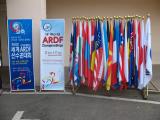
The main street in the Insadong neighborhood is Insadong-gil, which is an old, narrow cobblestone street filled with restaurants and small retail shops. Some of the shops were filled with tourist items, but many had fine ceramics, calligraphy, and artwork. One of our best meals was a dinner of dumpling soup and beer at a restaurant tucked away in one of the side alleys off the main street.

We spent five days in Seoul on our trip. Seoul is the capital city of South Korea, and one of the largest cities in the world. Located on the Han River in the northwest part of South Korea, Seoul was founded around 18 B.C., and today over 10 million people live in the city. Many of these photos were taken on a late Sunday morning walk through downtown Seoul with my uncle Tom.

Gyeongbokgung was the main royal palace of the kings of the Joseon dynasty (which ruled Korea from 1392 to 1910). Restoration of the palace began in 1990 and is ongoing. The National Folk Museum of Korea is located inside the Gyeongbokgung Palace wall, and is included in the ticket price for the palace.

On our second day in Korea, we spent the morning visiting the National Museum of Korea. The museum moved to its current facility in October, 2005, and is now the largest museum in Asia, and the sixth largest in the world. It features the largest collection in the world of Korean historical artifacts and artwork. Some of the collection includes art from other countries, especially Buddhist art from central Asia and India.

N Seoul Tower is a communications tower on top of Namsan Mountain in central Seoul. The top of the tower supports television and radio antennas. A multi-story observation deck partway up the tower included a snack shop, gift shops, and a full service Korean restaurant. Called both Seoul Tower and Namsan Tower in the past, the current ownership group uses the name N Seoul Tower.

Changdeokgung was one of the five major royal palaces in Seoul built for the kings of the Joseon dynasty. The layout of the palace is asymmetric, and designed to harmonize with the natural shape and aesthetics of the land, retaining most of the indigenous tree cover. Changdeokgung is recognized as a UNESCO World Heritage Site.

The Seoul Arts Center includes two art museums, an opera house, an orchestra hall, and a museum devoted to calligraphy. Next to this was the National Center for Traditional Korean Performing Arts, where we visited the Museum of Traditional Korean Music and watched a performance of traditional Korean musicians.

Jogyesa is the chief temple of the Jogye Order of Korean Buddhism. The Jogye Order is the largest monastic order of Buddhism in Korea, and shares a lot of spiritual principles with the Zen Buddhism practiced in Japan. The temple was first established in 1395, although this structure dates only to 1910. We visited during the temple's regular Sunday morning prayer service.

Deoksugung is one of the five royal grand palaces of Seoul. The palace was originally built in the sixteenth century for King Seongjong's elder brother, Prince Wolsan. Emperor Gojong moved into the palace in 1897, which he spent much of his time and energy renovating and expanding after a great fire in 1904.

On Sunday afternoon, we visited Namsangol Hanok Village, a project of the Seoul city government and the Korean Cultural Heritage Foundation. The village was a collection of old hanok, houses in the traditional style of the Joseon Dynasty, moved to this site. The houses were chosen for their culturally representative qualities.

Korean Folk Village is in Yongin, Gyeonggido, about 50 km (30 miles) south-southeast of downtown Seoul. The park features recreations of historical buildings and artifacts of rural life in Korea. It has been used as a set for several popular Korean television historical dramas.

Located on the banks of the Namhan River in far eastern Gyeonggido, Silleuksa is the only riverside Buddhist temple in Korea. It was founded around the year 580 by Silla Dynasty monk Wonhyo and remains an active religious temple today.

Jen and I attended the 14th World Amateur Radio Direction Finding Championships, September 2-7, 2008, in Hwaseong, Korea. It was the first world championships to be held in Korea, and only the second to be held in IARU Region III. Korea has the fourth largest amateur radio population in the world, with about 140,000 licensed operators. Jen was a competitor in the W21 (women, any age) category, and I was an international juror.

Hwaseong Fortress was constructed over a three-year period from 1794 to 1796 by Joseon Dynasty King Jeongjo. The fortress was dedicated to King Jeongjo's father, Prince Sado, whose tomb was moved to the site. The fortress was built using elements of both traditional Korean and modern western military technologies. Hwaseong Fortress is recognized as a UNESCO World Heritage Site.

Geolleung is the royal tomb of King Jeongjo (b. 1752) who ruled Korea from 1776 until his death in 1800, and his wife, Queen Hyoui (d. 1821). King Jeongjo established the Gyujanggak Royal Library, the oldest library in Korea. King Jeongjo also built Hwaseong Fortress in nearby Suwon.

After five days in Seoul, we travelled south to the city of Hwaseong. Hwaseong is located in Gyeonggido, a province that surrounds the city of Seoul on three sides: north, east, and south. Hwaseong is a city of about 360,000 people, and we did some travelling to the rural countryside around the city.